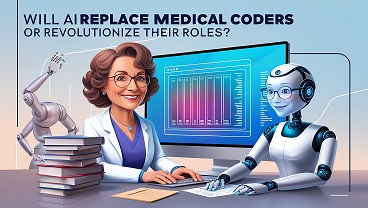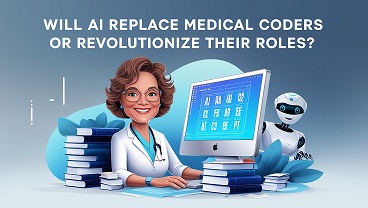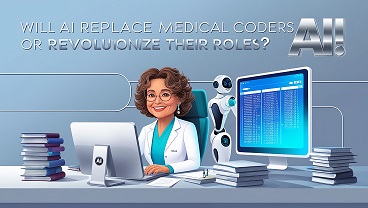As artificial intelligence continues to reshape healthcare, medical coders find themselves at a critical crossroads. 🤖 The burning question on everyone’s mind: human medical coders it will AI Replace Medical Coders obsolete? While this concern is valid, the reality is far more nuanced and potentially more exciting than many realize.
Think about this: In an era where a single hospital generates millions of medical records annually, traditional coding methods are becoming increasingly overwhelming. Medical coders face mounting pressure to process claims faster while maintaining accuracy in an ever-complex healthcare system. Yet, rather than spelling doom for the profession, AI is emerging as a powerful ally that could transform medical coding into a more strategic, efficient, and rewarding field.
Let’s explore how AI is reshaping medical coding, examine its real impact on coding professionals, and understand why the future might not be about replacement, but rather about revolution and enhancement. We’ll dive into the current landscape, emerging technologies, and what this means for the next generation of medical coding professionals. 🚀

Current State of Medical Coding
Traditional Coding Workflows and Challenges
Medical coders currently follow a complex workflow that involves reviewing clinical documentation, interpreting medical terminology, and assigning appropriate codes. This manual process requires extensive knowledge of ICD-10, CPT, and HCPCS coding systems, often leading to:
- Documentation review bottlenecks
- Interpretation inconsistencies
- Code assignment delays
- Resource-intensive auditing processes
Rising Healthcare Documentation Demands
The healthcare industry faces unprecedented documentation demands:
| Factor | Impact on Coding |
|---|---|
| Patient Volume | 30% increase in coding workload |
| Documentation Detail | 2x more complex than 5 years ago |
| Regulatory Requirements | 40% more time spent on compliance |
Accuracy Rates in Manual Coding
Current manual coding accuracy rates typically range between 80-95%, depending on:
- Coder experience level
- Case complexity
- Time constraints
- Documentation quality
Despite best efforts, human error remains a significant concern, with an average error rate of 5-15% in complex cases. These challenges have created a pressing need for more efficient solutions, particularly as healthcare organizations manage increasing patient volumes and regulatory requirements.
Looking ahead, these existing challenges make it crucial to examine how AI technologies are transforming the medical coding landscape.

AI Technologies Transforming Medical Coding
Natural Language Processing Capabilities
NLP technology enables AI systems to understand and interpret medical documentation with remarkable accuracy. These systems can analyze clinical notes, physician narratives, and patient records to extract relevant information for coding purposes.
Machine Learning Algorithms in Code Selection
ML algorithms significantly streamline the coding process through:
- Pattern recognition in diagnostic data
- Automatic code suggestion based on clinical documentation
- Continuous learning from coding decisions
- Historical data analysis for improved accuracy
Computer-Assisted Coding Tools
Modern CAC tools integrate seamlessly with existing workflows:
| Feature | Benefit |
|---|---|
| Auto-code suggestion | Reduces manual effort |
| Real-time analysis | Speeds up coding process |
| Integration with EHR | Ensures data consistency |
| Compliance checking | Minimizes coding errors |
Real-Time Validation Systems
These systems provide immediate feedback on code selection and help maintain coding accuracy by:
- Flagging potential errors or inconsistencies
- Suggesting alternative codes when appropriate
- Ensuring compliance with coding guidelines
- Maintaining coding quality standards
AI technologies are revolutionizing medical coding through advanced automation and intelligent assistance. The integration of these tools has led to increased productivity and accuracy in code assignment. As we explore the impact on medical coding jobs, it’s important to understand how these technological advances are reshaping the role of coding professionals rather than replacing them entirely.

Impact on Medical Coding Jobs
Tasks Being Automated
AI systems are increasingly handling routine coding tasks:
- Basic diagnosis code assignment
- Procedure code matching
- Charge capture automation
- Simple claims processing
- Routine documentation review
New Skill Requirements
Today’s medical coders need a blend of traditional and modern skills:
| Traditional Skills | New Technical Skills |
|---|---|
| Medical terminology | AI system operation |
| Anatomy knowledge | Data analytics |
| Coding guidelines | Quality assurance |
| Compliance expertise | Software proficiency |
Shifting Job Responsibilities
Medical coders are evolving from pure coding specialists to coding quality analysts. Key responsibilities now include:
- Reviewing AI-generated codes for accuracy
- Managing complex cases that AI cannot handle
- Providing feedback to improve AI algorithms
- Ensuring compliance with changing regulations
- Acting as liaison between technical and clinical teams
While AI automates routine tasks, it creates opportunities for medical coders to develop higher-value skills. Rather than replacing coders, automation is elevating their roles to focus on complex decision-making and quality control. Coders who adapt to these changes become invaluable assets in healthcare organizations, combining their clinical knowledge with technical expertise.
Now that we understand how jobs are changing, let’s explore the benefits of AI and human collaboration in medical coding.
Benefits of AI-Human Collaboration
Improved Coding Accuracy
AI systems, working alongside human coders, achieve remarkable accuracy rates through dual-verification processes. Machine learning algorithms catch common errors while human experts validate complex cases, creating a powerful system of checks and balances.
Faster Processing Times
The combination of AI and human expertise dramatically reduces coding turnaround times:
- AI handles routine cases in seconds
- Humans focus on complex scenarios
- Parallel processing capabilities
- Real-time error detection
| Process | Traditional Method | AI-Human Collaboration |
|---|---|---|
| Simple Claims | 20-30 min | 1-2 min |
| Complex Claims | 45-60 min | 15-20 min |
| Daily Output | 50-75 claims | 200-250 claims |
Cost Reduction
Smart allocation of resources between AI and human coders leads to significant cost savings through:
- Reduced overtime hours
- Decreased error-related expenses
- Lower training costs
- Optimized workforce distribution
Enhanced Compliance
AI tools continuously update regulatory requirements while human coders provide contextual interpretation, ensuring:
- Accurate code assignment
- Current compliance standards
- Reduced audit risks
- Better documentation
Better Revenue Cycle Management
The synergy between AI and human expertise streamlines the revenue cycle by minimizing denials and optimizing reimbursement rates. This partnership ensures accurate first-pass claims while maintaining high-quality standards.
Now that we’ve explored the advantages of AI-human collaboration, let’s examine the evolving landscape of medical coding professionals and their future roles.
Future of Medical Coding Professionals
Emerging Career Opportunities
- AI Implementation Specialist
- Medical Coding Auditor
- Clinical Documentation Improvement Specialist
- Healthcare Data Analyst
- AI-Assisted Coding Supervisor
Medical coders are evolving into strategic roles that combine traditional coding expertise with technology oversight. These positions offer higher compensation and greater responsibility in healthcare operations.
Required Technical Competencies
| Traditional Skills | New Technical Skills |
|---|---|
| ICD-10 Knowledge | AI System Management |
| CPT Coding | Data Analytics |
| Medical Terminology | Machine Learning Basics |
| Compliance Knowledge | Programming Fundamentals |
| Documentation Review | System Validation |
Role Evolution from Coder to Data Validator
Medical coding professionals are transitioning from manual code assignment to becoming expert validators of AI-generated codes. This evolution requires:
- Development of critical thinking skills to identify AI coding patterns
- Understanding of machine learning algorithms and their limitations
- Ability to provide feedback for AI system improvement
- Expertise in quality assurance and accuracy verification
- Knowledge of advanced analytics tools
The role now focuses on ensuring AI systems maintain high accuracy while handling complex cases that require human judgment. Medical coders are becoming integral in training AI systems, identifying edge cases, and maintaining coding quality standards. Their expertise is crucial in maintaining the balance between automation efficiency and coding accuracy.
Now that we understand the evolving landscape, let’s examine the challenges healthcare organizations face when implementing these AI solutions.
- An Insider’s AI Tools List That Will Revolutionize Your Workflow
- Will AI Replace Accountants by 2030 What You Need to Know Now
Implementation Challenges
Training Requirements
Medical facilities implementing AI coding solutions face significant upfront training challenges. Staff need comprehensive education on:
- Basic AI concepts and functionality
- New software interfaces and workflows
- Updated compliance protocols
- Quality assurance procedures
Cost Considerations
The financial impact of AI implementation varies across healthcare organizations:
| Cost Category | Initial Investment | Ongoing Expenses |
|---|---|---|
| Software License | $50,000-200,000 | Annual subscription |
| Infrastructure | $20,000-100,000 | Maintenance fees |
| Staff Training | $5,000-25,000/year | Continuing education |
| Support Services | Variable | Monthly/quarterly fees |
Integration with Existing Systems
Healthcare organizations must address several technical hurdles:
- EHR compatibility issues
- Legacy system connections
- Data migration challenges
- Security protocol alignment
- Workflow disruption management
Resistance to Change
Human factors present significant implementation barriers:
- Experienced coders fear job displacement
- Staff anxiety about learning new technologies
- Concerns about AI accuracy and reliability
- Reluctance to modify established workflows
- Skepticism about ROI and benefits
Despite these challenges, healthcare organizations can overcome these obstacles through careful planning, transparent communication, and phased implementation approaches. Success requires balancing technological advancement with human concerns while maintaining focus on improved patient care and operational efficiency.
Conclusion
The fusion of AI and medical coding marks a transformative era in healthcare administration. While AI streamlines routine coding tasks and reduces errors, it doesn’t signal the end of medical coding professionals. Instead, it elevates their roles to focus on complex decision-making, quality assurance, and strategic oversight.
Medical coders who embrace AI as a powerful ally will thrive in this evolving landscape. By developing new skills and adapting to technological advances, these professionals will become indispensable partners in healthcare delivery, ensuring both accuracy in medical records and optimal reimbursement outcomes. The future belongs to those who can effectively combine human expertise with AI capabilities to deliver superior coding solutions.
